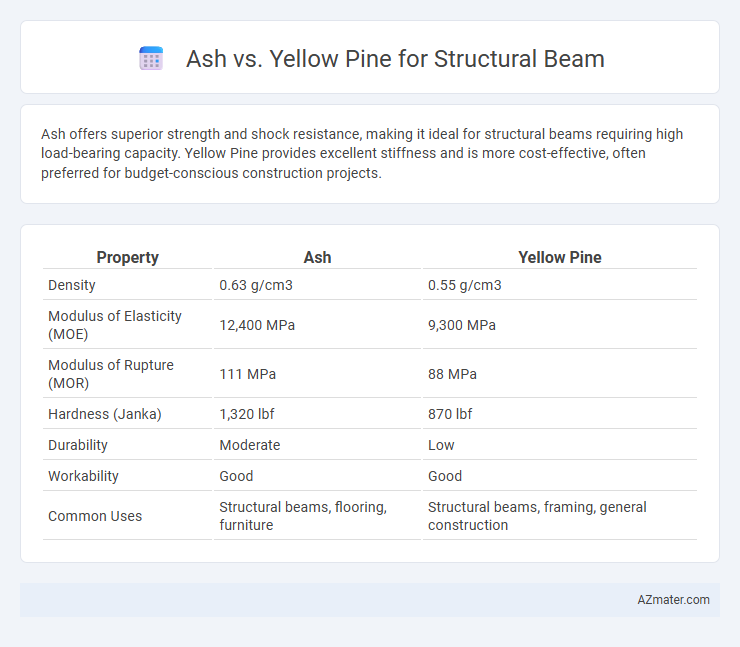Ash offers superior strength and shock resistance, making it ideal for structural beams requiring high load-bearing capacity. Yellow Pine provides excellent stiffness and is more cost-effective, often preferred for budget-conscious construction projects.
Table of Comparison
| Property | Ash | Yellow Pine |
|---|---|---|
| Density | 0.63 g/cm3 | 0.55 g/cm3 |
| Modulus of Elasticity (MOE) | 12,400 MPa | 9,300 MPa |
| Modulus of Rupture (MOR) | 111 MPa | 88 MPa |
| Hardness (Janka) | 1,320 lbf | 870 lbf |
| Durability | Moderate | Low |
| Workability | Good | Good |
| Common Uses | Structural beams, flooring, furniture | Structural beams, framing, general construction |
Introduction to Ash and Yellow Pine as Structural Beams
Ash wood features a high strength-to-weight ratio and excellent shock resistance, making it a popular choice for structural beams in construction. Yellow Pine is renowned for its durability, density, and load-bearing capacity, often used in heavy framing and structural applications. Both species provide reliable support, with Ash offering flexibility and Yellow Pine delivering robust compressive strength for long-lasting structural performance.
Wood Species Overview: Ash vs Yellow Pine
Ash and Yellow Pine are popular wood species for structural beams due to their strength and durability. Ash offers high elasticity and shock resistance, making it suitable for applications requiring flexibility and impact absorption. Yellow Pine, particularly Southern Yellow Pine, provides superior density and compressive strength, ideal for load-bearing structures and long spans.
Strength and Load-Bearing Capacity Comparison
Ash offers superior strength and load-bearing capacity compared to yellow pine, making it ideal for heavy structural beams. Its high density and hardness contribute to better resistance under stress, with an average bending strength of about 14,300 psi versus yellow pine's approximately 12,000 psi. The enhanced durability of ash supports greater loads and reduces deflection, ensuring long-lasting performance in construction applications.
Durability and Resistance to Decay
Ash offers superior durability and excellent resistance to wear, making it a reliable choice for structural beams requiring strength and longevity. Yellow Pine provides strong structural support but is more susceptible to decay without proper treatment, especially in moisture-prone environments. Ash's natural resistance to decay outperforms untreated Yellow Pine, enhancing its suitability for long-lasting, durable beam applications.
Workability and Ease of Fabrication
Ash offers superior workability and ease of fabrication compared to Yellow Pine due to its fine, straight grain and uniform texture, allowing for smooth cutting, shaping, and sanding. Yellow Pine, while strong and durable, tends to have a coarser grain and higher resin content, which can make machining and finishing more challenging and may require additional effort in tools maintenance. For structural beams requiring precision and a clean finish, Ash is often preferred by craftsmen and builders aiming for efficient handling and consistent results.
Cost and Availability in Construction Markets
Ash beams often come with a higher price tag due to their denser grain structure and superior strength, making them a premium choice in structural applications. Yellow Pine is generally more affordable and widely available in most construction markets across North America, favored for its cost efficiency and ease of sourcing. The abundance of Yellow Pine in lumber yards and suppliers ensures quicker lead times, while Ash may require longer procurement periods depending on regional supply.
Environmental Impact and Sustainability
Ash beams offer exceptional durability and strength while being sourced from rapidly renewable broadleaf hardwood forests, promoting sustainable forestry practices. Yellow Pine, often harvested from managed coniferous plantations, contributes to carbon sequestration but may involve more intensive chemical treatments during processing. Choosing ash can reduce environmental impact due to its longevity and lower need for preservatives, whereas Yellow Pine's faster growth cycle supports reforestation efforts but may have a higher ecological footprint related to processing.
Typical Applications in Building Structures
Ash provides excellent strength and flexibility, making it suitable for heavy-duty structural beams in residential and commercial buildings where load-bearing and impact resistance are critical. Yellow Pine, known for its high density and stiffness, is often used in framing, joists, and support beams in construction due to its durability and cost-effectiveness. Both woods are favored for their ability to withstand stress and support structural integrity in various building applications.
Maintenance Requirements Over Time
Ash structural beams require moderate maintenance to prevent moisture damage and maintain their natural strength, benefiting from periodic sealing or staining to enhance durability. Yellow Pine beams, known for their dense grain and natural resistance to decay, typically demand less frequent treatment but still require occasional inspection for signs of rot or insect infestation. Over time, both wood types respond well to proper maintenance practices that include regular cleaning, moisture control, and prompt repairs to extend structural integrity.
Conclusion: Choosing Between Ash and Yellow Pine for Structural Beams
Ash offers superior strength and shock resistance, making it ideal for structural beams requiring high load-bearing capacity and durability. Yellow pine provides excellent stiffness and is more cost-effective, suitable for general construction with moderate load requirements. Select ash for heavy-duty applications where resilience is critical, and choose yellow pine for budget-conscious projects prioritizing stiffness and availability.

Infographic: Ash vs Yellow Pine for Structural Beam
 azmater.com
azmater.com